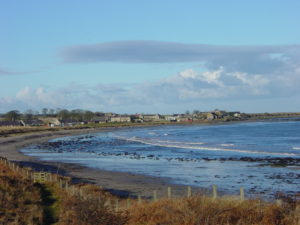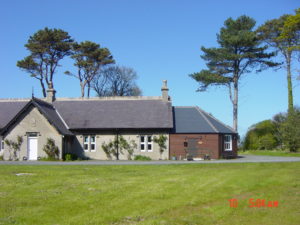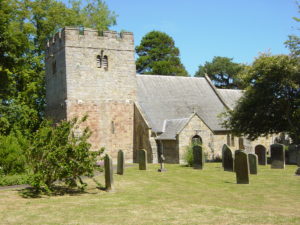The Vision
The vision sets out what the Longhoughton, Boulmer and Howick Neighbourhood Plan intends to achieve over the plan period to 2036. It informs all the plan objectives and draft planning policies. The vision and objectives were informed by the issues identified through early engagement and there was a separate consultation on the draft vision and objectives in January 2020.
In 2036 the Parish of Longhoughton which includes the unique and distinctive villages of Boulmer, Howick and Longhoughton, will be an attractive place to live and grow with a community that is sustainable, cohesive and thriving. The diverse needs and wellbeing of the existing and future residents will be provided for and the community will be sustainable in relation to the facilities and infrastructure available to residents. Residents will have good access to facilities and be well connected
The natural, historic and environmental character of the area will be maintained and enhanced for future generations by ensuring that new developments are of an appropriate quality, scale and design and embed important habitats for wildlife.
New development will minimize environmental harm by ensuring the prudent use of natural resources in both construction and occupation. It will be designed to be resistant to the effects of climate change.
All people who live in the parish will have the opportunity to participate in shaping their surroundings and feel proud of where they live.
The Objectives
To deliver the vision, seven objectives have been developed. These clearly relate to the issues identified through early engagement with the local community and other stakeholders, as well as the evidence base supporting the plan. The draft planning policies and community actions contained within the plan, should deliver the objectives.
1 Sustainable Development. Ensuring new development makes a positive contribution to social, environmental or economic needs and that any negative impacts, particularly those contributing to climate change, are adequately mitigated.
2 Housing. The location, quantity and type of housing built in the Parish, is appropriate to its sustainability and reflects the distinct character and needs of the villages of Boulmer, Howick and Longhoughton.
3 Business. Supporting and encouraging appropriate and sustainable levels of business growth and development across the Parish.
4 Environment. Protecting and improving the natural environment of the parish by: conserving and enhancing the natural beauty of the Northumberland Coast Area of Natural Beauty; protecting the integrity of the internationally designated coastal sites; and supporting the creation, protection and enhancement of biodiversity and green infrastructure networks.
5 Heritage. Protecting and enhancing the distinctive character of the villages and the built heritage of the Parish.
6 Community. Protecting and supporting the development of key community facilities and infrastructure to ensure that the community is inclusive and sustainable.
7 Transport and Access. Promoting access to facilities and services for all the residents and creating safe and high-quality roads, pavements and green routes including footpaths, cycle routes and bridleways.
Characteristics and Features
The following information defines the parish and the villages in terms of its characteristics and features and the what people like about where they live.
The three rural villages of Boulmer, Howick and Longhoughton occupy approximately three miles of the coastline east of Alnwick in Northumberland between the Howick Fault and Seaton Point on the coast. This north-south coast is designated as an area of outstanding natural beauty (AONB) which is between a mile and two miles wide at any point. The low laying rocky shoreline is punctuated by fine sandy beaches at Rumbling Kern, Sugar Sands, Howdiemont Sands and Boulmer Haven. It is a very popular place for birdwatching. To the west, Alnwick is less than five miles away and beyond are the Cheviot Hills. The prevailing weather through the year tends to come from the west forcing much of the rain to fall in Cumbria and on the north Pennines before reaching Northumberland. However, there can be high winds and cold blasts when it comes from the north east and the east.

The economy here is predominantly agriculture, fishery and tourism, but the presence of RAF Boulmer adds a significant element to its uniqueness. The area accommodates RAF personnel and their families and this includes Ministry of Defence built properties in Longhoughton. Howick Gardens is a unique and significant tourist attraction and local employer. There are also a number of holiday cottages and second homes, which means that the villages tend to be busier in the summer and during school holidays. In recent years there has been a steady increase in the amount of house building and in 2021 Story Homes completed building sixty six homes in Chancel Place.
Boulmer
The cluster of single story buildings that were the homes of Boulmer fishermen is the main feature that defines the village. These homes are located on the dunes just above sea level. The Fishing Boat Inn is part of this cluster and is a favourite with visitors. It features a Victorian painting by Arthur Marsh which shows the lifeboat being launched by the village women in their long skirts. To the south of this cluster of houses is the sweeping bay of Boulmer Haven and beyond the more rugged dunes of Seaton Point. Boulmer is favoured by tourists and visitors and 40% of properties are either holiday lets or second homes.
Other than the Fishing Boat Inn and a small gallery, there are no other commercial buildings in the village but inshore fishing from Boulmer Haven still takes place with two boats regularly fishing for crabs, lobsters and salmon in season.
The largest employer in the Ward is RAF Boulmer that occupies a site between Boulmer and Longhoughton. There is one working farm and close to Seaton Point there are two caravan sites for permanent holiday caravans. Boulmer has its own village hall which is a First World War Barrack hut that has recently been refurbished.
A national cycling route (1) passes through Boulmer along with the St Oswald’s Way long distance walking route and the new round Britain walking route will also come through the village. Boulmer beach and dunes are a favourite with local people for dog walking and all year round sea swimmers.
Boulmer people are proud of their village and the heritage that reflects dependence on fishing and the sea. Many families have links with sea rescues and the Boulmer Voluntary Rescue Service still takes that role.
People do not want to see the village spoiled by inappropriate development and value the AONB status. They see the lack of affordable housing as a barrier to the future sustainability of the community.
Howick
The residents of Howick obviously love where they live for its location, history, wildlife, outstanding beauty and the tranquility of estate life here. They tend to travel to Alnwick for their domestic needs such as medical services and regular shopping, and they all know each other since the number of villagers is small.

Howick is dominated by Howick Hall estate and its extensive gardens, exactly a mile from the sea at Rumbling Kern, which features Earl Grey’s Bathing House, now a holiday cottage. The estate built village is mostly well spaced, period single story, stone built dwellings and is surrounded by farms which feature sheep and cattle on sumptuous green pasture and arable crops. The area is well wooded, and conceals Howick Burn, reputedly a fine trout stream. There are pleasant walks across and through the parish, not least St Oswald’s Way, the coastal path and the National Cycle Route which also links Howick with Longhoughton and Boulmer.
Little Houghton is part of the Howick Estate and is located across the east coast rail line and a little further inland. The fact that Howick village was built with the same materials, at the same time around 1842, makes it visually extremely attractive and cohesive. All but one of the properties is leased from Howick estate. The cottages hug the land and were obviously designed to duck the worst of the coastal weather. St Michael and all Angels church is in the grounds of Howick Hall and there was once a small school here too, now a holiday let. The Old Rectory offers very comfortable bed and breakfast accommodation in the centre of the village. The residents highly value their village hall, but there are no retail facilities to bring villagers together in other ways.
There are two historic sites worthy of mention here. One is the Mesolithic settlement which was billed by the BBC to feature Britain’s oldest stone-age hunter-gatherer house, believed to have been occupied for around one hundred years, and it features Bronze Age burials too. The other is the Wreck of the Tadorne, a French steam trawler which foundered at Howick Haven on 29 March 1913. Only the boiler remains to be seen in a falling tide now, and the sailors who lost their lives are buried in Howick churchyard. The geology of this coastline is also remarkable to the extent that Durham and Newcastle University send groups of geology students annually for field work here.
Longhoughton
Longhoughton is a Northumbrian coastal village with access by road through Low Steads Farm to St Oswald’s Way, a National Cycle Path and the sea at Howdiemont Beach less than a mile away. The Norman Church was the centre of the village for centuries, where the vicarage was also built along with a small school adjacent to School Green by the gates of Longhoughton Hall. The centre of School Green is currently marked with a sculpture by Gilbert Ward, installed in 2004. The development of the village through time ran north and south from this centre; hence the road names of North End and South End from which small farms once extended east and west. With the building of the housing estates and the current convenience store, the Community and Sports Centre and the RAF Families Centre, the centre of the village has arguably moved a little north for many. There is a popular youth club, community groups and various active sports groups in the village and the Primary School is well regarded and valued (currently Ofsted ‘Good’).

The RAF housing makes the village different from most others and there is a variety of architectural styles which make up the village now. There are the traditional stone built dwellings and barns alongside the twentieth and twenty first century estates. The population also reflects those who have lived here for a very long time, with the relatively recent incomers and the RAF personnel who are more transient. Crime is rare here and there is evidence that some ex-RAF folk retire and settle here such are the attractions of life in a village with such friendly and welcoming people, the beauty of its environment and the local amenities mentioned above. Although Longhoughton has a rural or slightly remote ambiance, it has transport links by bus, by the east coast train line from Alnmouth about three miles away, and by the two international airports at Newcastle and Edinburgh.
Northumbrian people tend to be proud of their county and of their identity in general terms, but the evidence is that the people of Longhoughton overwhelmingly love where they live. For example, there is a large cohort of dog owners who often walk their pets together at various times of the day around the many much valued and plentiful trees and open spaces. They exercise both the dogs and their cultural preference for conversation which is open, warm and grounded, as is the case for the majority of other residents too.
The Neighbourhood Development Plan Steering Group believes that these are the distinctive qualities of Longhoughton that go to make up what the population value about where they live. The Longhoughton Review of 2018 provided the evidence of the perceived needs and issues which are being taken forward in the writing of a Development Plan, including the need for a strategic plan in light of a lack of investment in infrastructure and community facilities.